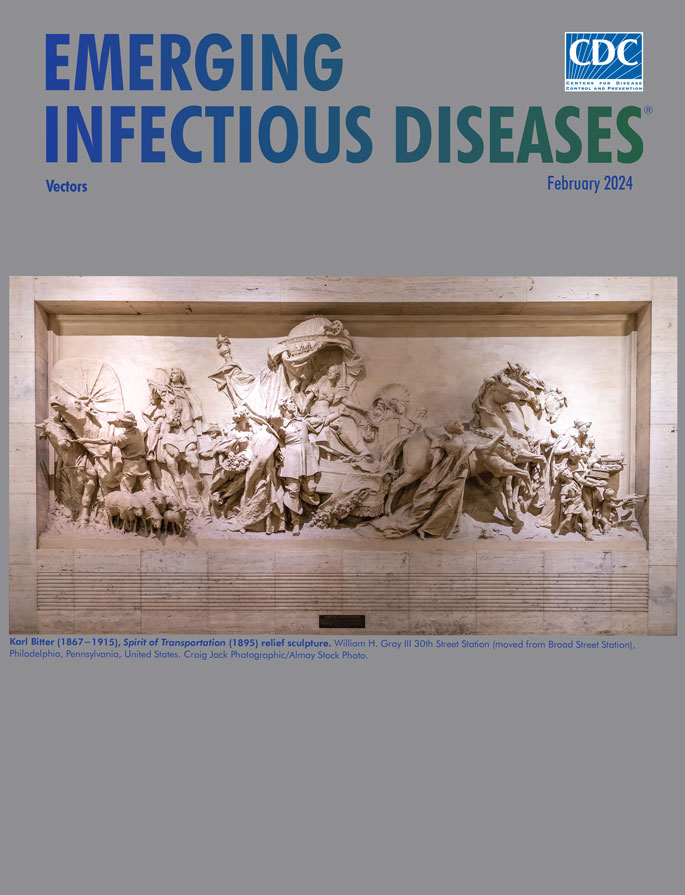Drivers of Crimean-Congo Hemorrhagic Fever in Natural Host and Effects of Control Measures, Bulgaria.
IF 6.6
2区 医学
Q1 IMMUNOLOGY
引用次数: 0
Abstract
Crimean-Congo hemorrhagic fever (CCHF) is an emerging tickborne disease and a World Health Organization priority. Although humans are accidental hosts, infection can lead to hemorrhagic fever with a high fatality rate. Domestic animals play a critical role in disease transmission, but infected animals do not show clinical signs and viremia is short; thus, CCHF virus (CCHFV) infections can remain unobserved. During 2017-2019, we conducted 2 sequential observational studies followed by a multisite randomized controlled trial to determine spatial-temporal patterns and quantify drivers for CCHFV exposure in a natural host (sheep) in a CCHF-endemic area of Bulgaria. We found high-risk areas embedded in endemic regions. Animal characteristics were not correlated with seropositivity; however, a seasonality effect was observed, suggesting sampling time was a potential confounder. Force of infection varied across farms and over time. CCHFV transmission heterogeneity among farms is driven by preventive measures used to reduce exposure to ticks.克里米亚-刚果出血热在自然宿主中的驱动因素和控制措施的效果,保加利亚。
克里米亚-刚果出血热(CCHF)是一种新兴的蜱传疾病,也是世界卫生组织的优先事项。虽然人类是意外宿主,但感染可导致死亡率高的出血热。家畜在疾病传播中起关键作用,但感染动物无临床症状,病毒血症短;因此,CCHF病毒(CCHFV)感染可以不被观察到。在2017-2019年期间,我们进行了2项连续观察性研究,随后进行了一项多地点随机对照试验,以确定保加利亚cchf流行地区CCHFV自然宿主(羊)暴露的时空模式并量化驱动因素。我们在流行地区发现了高风险地区。动物特征与血清阳性无相关性;然而,观察到季节性效应,表明采样时间是一个潜在的混杂因素。感染的力量在不同的农场和时间有所不同。CCHFV在农场间传播的异质性是由减少接触蜱虫的预防措施造成的。
本文章由计算机程序翻译,如有差异,请以英文原文为准。
求助全文
约1分钟内获得全文
求助全文
来源期刊

Emerging Infectious Diseases
医学-传染病学
CiteScore
17.30
自引率
1.70%
发文量
505
审稿时长
1 months
期刊介绍:
Emerging Infectious Diseases is a monthly open access journal published by the Centers for Disease Control and Prevention. The primary goal of this peer-reviewed journal is to advance the global recognition of both new and reemerging infectious diseases, while also enhancing our understanding of the underlying factors that contribute to disease emergence, prevention, and elimination.
Targeted towards professionals in the field of infectious diseases and related sciences, the journal encourages diverse contributions from experts in academic research, industry, clinical practice, public health, as well as specialists in economics, social sciences, and other relevant disciplines. By fostering a collaborative approach, Emerging Infectious Diseases aims to facilitate interdisciplinary dialogue and address the multifaceted challenges posed by infectious diseases.
 求助内容:
求助内容: 应助结果提醒方式:
应助结果提醒方式:


